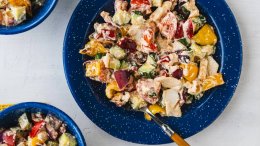While pickling and brining both require submerging foods into a liquid, the two processes are quite different and yield different results.
Salt and water make up a classic brine, which can then be used to flavour and enhance the texture of different foods, from vegetables to meat and fish. In meat, the salt breaks down the structure of the muscle, which allows more liquid to enter the meat, which makes for a more moist product. Additionally, the salt keeps the meat's proteins from coagulating as densely as it would without the brine, which makes for a more tender piece of meat. The brining time for different ingredients vary and depends on the size, but it usually takes anywhere from around one hour to days.
Different from brining, pickling is a method to preserve food by immersing it in brine or acidic solution, and can include the fermentation process. The primary goal of pickling is to preserve the food.
If you want to make your own brine, a good ratio to follow is four heaping tablespoons of coarse sea salt (or pickling salt) to every litre of water.













